Analysis of Construction Procurement Strategies and Systems
VerifiedAdded on 2022/08/22
|23
|4904
|18
Report
AI Summary
This report provides a detailed analysis of strategic construction procurement systems. It explores four key methods: Design & Construct (D&C), Partnering, Alliancing, and Public-Private Partnerships (PPP). The report defines each system, outlines its key characteristics, and details the implementation process, highlighting contractual and functional relationships. It further compares the advantages and disadvantages of each approach, offering insights into their suitability for different construction projects. The D&C section covers variations like Direct and Competitive, while Partnering emphasizes trust and long-term commitment. Alliancing and PPP methods are also thoroughly examined, including their definitions, implementation, and associated merits and demerits. This comprehensive analysis aims to provide a deep understanding of these procurement systems and their practical applications in the construction industry.
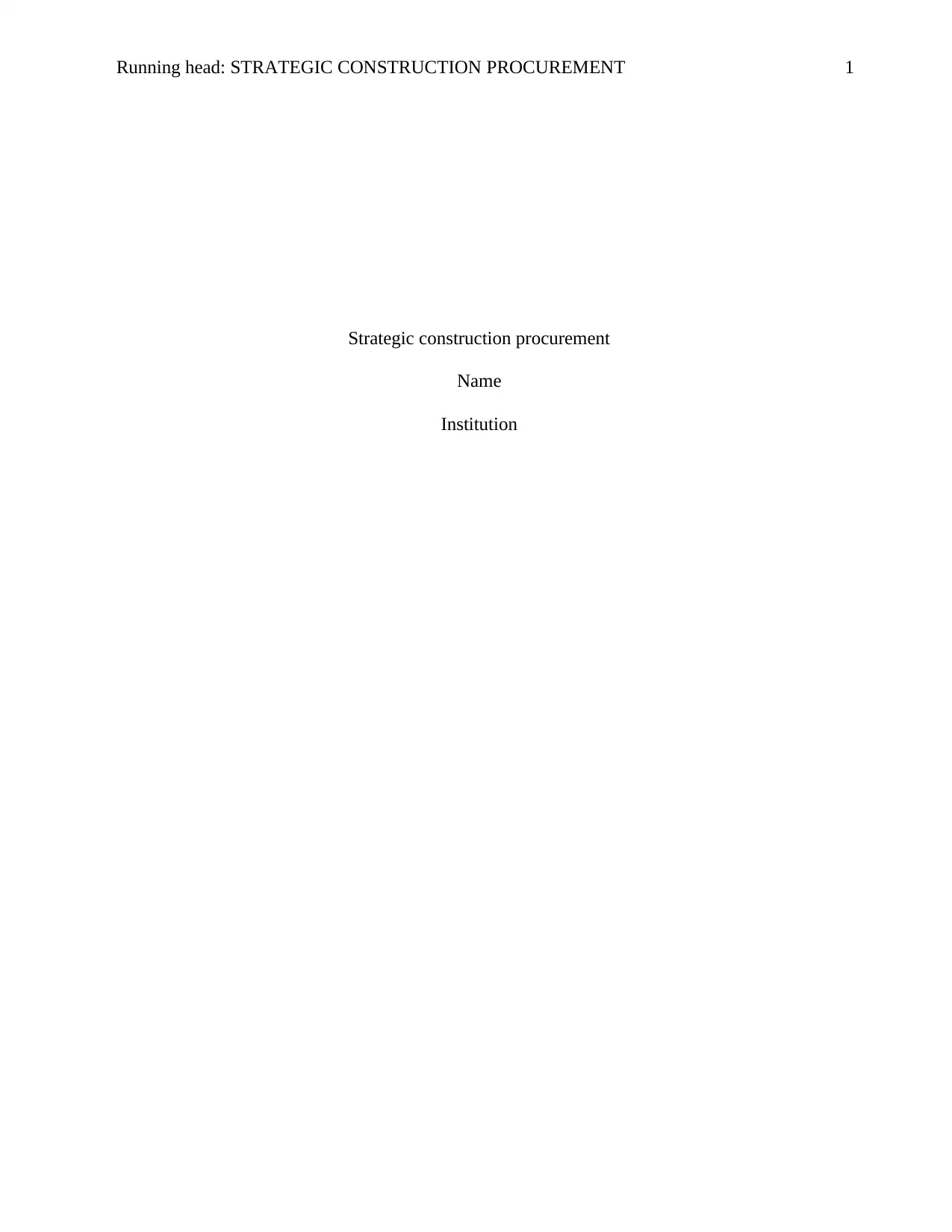
Running head: STRATEGIC CONSTRUCTION PROCUREMENT 1
Strategic construction procurement
Name
Institution
Strategic construction procurement
Name
Institution
Paraphrase This Document
Need a fresh take? Get an instant paraphrase of this document with our AI Paraphraser
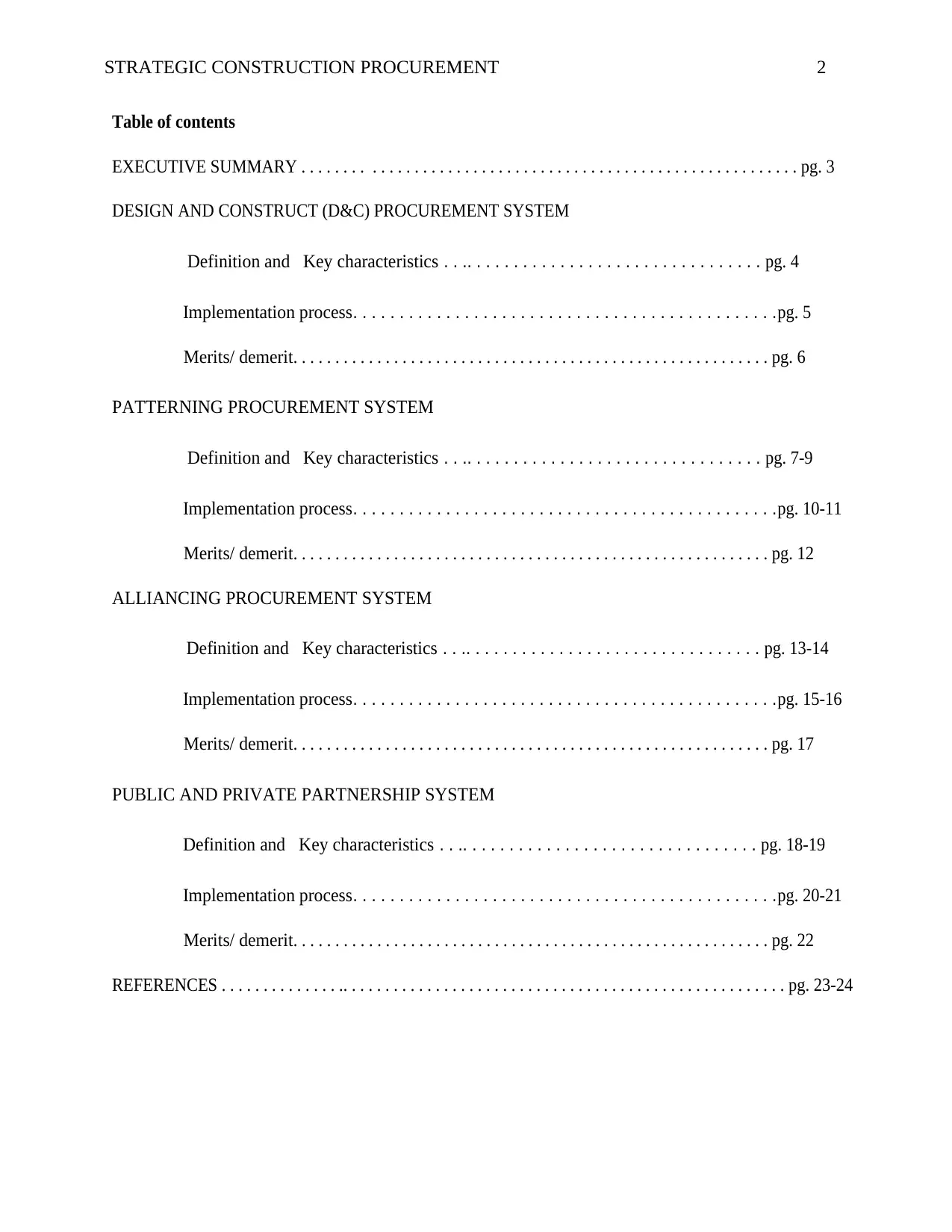
STRATEGIC CONSTRUCTION PROCUREMENT 2
Table of contents
EXECUTIVE SUMMARY . . . . . . . . . . . . . . . . . . . . . . . . . . . . . . . . . . . . . . . . . . . . . . . . . . . . . . . . . . . pg. 3
DESIGN AND CONSTRUCT (D&C) PROCUREMENT SYSTEM
Definition and Key characteristics . . .. . . . . . . . . . . . . . . . . . . . . . . . . . . . . . . . pg. 4
Implementation process . . . . . . . . . . . . . . . . . . . . . . . . . . . . . . . . . . . . . . . . . . . . . .pg. 5
Merits/ demerit . . . . . . . . . . . . . . . . . . . . . . . . . . . . . . . . . . . . . . . . . . . . . . . . . . . . . . . . . pg. 6
PATTERNING PROCUREMENT SYSTEM
Definition and Key characteristics . . .. . . . . . . . . . . . . . . . . . . . . . . . . . . . . . . . pg. 7-9
Implementation process . . . . . . . . . . . . . . . . . . . . . . . . . . . . . . . . . . . . . . . . . . . . . .pg. 10-11
Merits/ demerit . . . . . . . . . . . . . . . . . . . . . . . . . . . . . . . . . . . . . . . . . . . . . . . . . . . . . . . . . pg. 12
ALLIANCING PROCUREMENT SYSTEM
Definition and Key characteristics . . .. . . . . . . . . . . . . . . . . . . . . . . . . . . . . . . . pg. 13-14
Implementation process . . . . . . . . . . . . . . . . . . . . . . . . . . . . . . . . . . . . . . . . . . . . . .pg. 15-16
Merits/ demerit . . . . . . . . . . . . . . . . . . . . . . . . . . . . . . . . . . . . . . . . . . . . . . . . . . . . . . . . . pg. 17
PUBLIC AND PRIVATE PARTNERSHIP SYSTEM
Definition and Key characteristics . . .. . . . . . . . . . . . . . . . . . . . . . . . . . . . . . . . pg. 18-19
Implementation process . . . . . . . . . . . . . . . . . . . . . . . . . . . . . . . . . . . . . . . . . . . . . .pg. 20-21
Merits/ demerit . . . . . . . . . . . . . . . . . . . . . . . . . . . . . . . . . . . . . . . . . . . . . . . . . . . . . . . . . pg. 22
REFERENCES . . . . . . . . . . . . . . .. . . . . . . . . . . . . . . . . . . . . . . . . . . . . . . . . . . . . . . . . . . . . . . . . . . . . pg. 23-24
Table of contents
EXECUTIVE SUMMARY . . . . . . . . . . . . . . . . . . . . . . . . . . . . . . . . . . . . . . . . . . . . . . . . . . . . . . . . . . . pg. 3
DESIGN AND CONSTRUCT (D&C) PROCUREMENT SYSTEM
Definition and Key characteristics . . .. . . . . . . . . . . . . . . . . . . . . . . . . . . . . . . . pg. 4
Implementation process . . . . . . . . . . . . . . . . . . . . . . . . . . . . . . . . . . . . . . . . . . . . . .pg. 5
Merits/ demerit . . . . . . . . . . . . . . . . . . . . . . . . . . . . . . . . . . . . . . . . . . . . . . . . . . . . . . . . . pg. 6
PATTERNING PROCUREMENT SYSTEM
Definition and Key characteristics . . .. . . . . . . . . . . . . . . . . . . . . . . . . . . . . . . . pg. 7-9
Implementation process . . . . . . . . . . . . . . . . . . . . . . . . . . . . . . . . . . . . . . . . . . . . . .pg. 10-11
Merits/ demerit . . . . . . . . . . . . . . . . . . . . . . . . . . . . . . . . . . . . . . . . . . . . . . . . . . . . . . . . . pg. 12
ALLIANCING PROCUREMENT SYSTEM
Definition and Key characteristics . . .. . . . . . . . . . . . . . . . . . . . . . . . . . . . . . . . pg. 13-14
Implementation process . . . . . . . . . . . . . . . . . . . . . . . . . . . . . . . . . . . . . . . . . . . . . .pg. 15-16
Merits/ demerit . . . . . . . . . . . . . . . . . . . . . . . . . . . . . . . . . . . . . . . . . . . . . . . . . . . . . . . . . pg. 17
PUBLIC AND PRIVATE PARTNERSHIP SYSTEM
Definition and Key characteristics . . .. . . . . . . . . . . . . . . . . . . . . . . . . . . . . . . . pg. 18-19
Implementation process . . . . . . . . . . . . . . . . . . . . . . . . . . . . . . . . . . . . . . . . . . . . . .pg. 20-21
Merits/ demerit . . . . . . . . . . . . . . . . . . . . . . . . . . . . . . . . . . . . . . . . . . . . . . . . . . . . . . . . . pg. 22
REFERENCES . . . . . . . . . . . . . . .. . . . . . . . . . . . . . . . . . . . . . . . . . . . . . . . . . . . . . . . . . . . . . . . . . . . . pg. 23-24
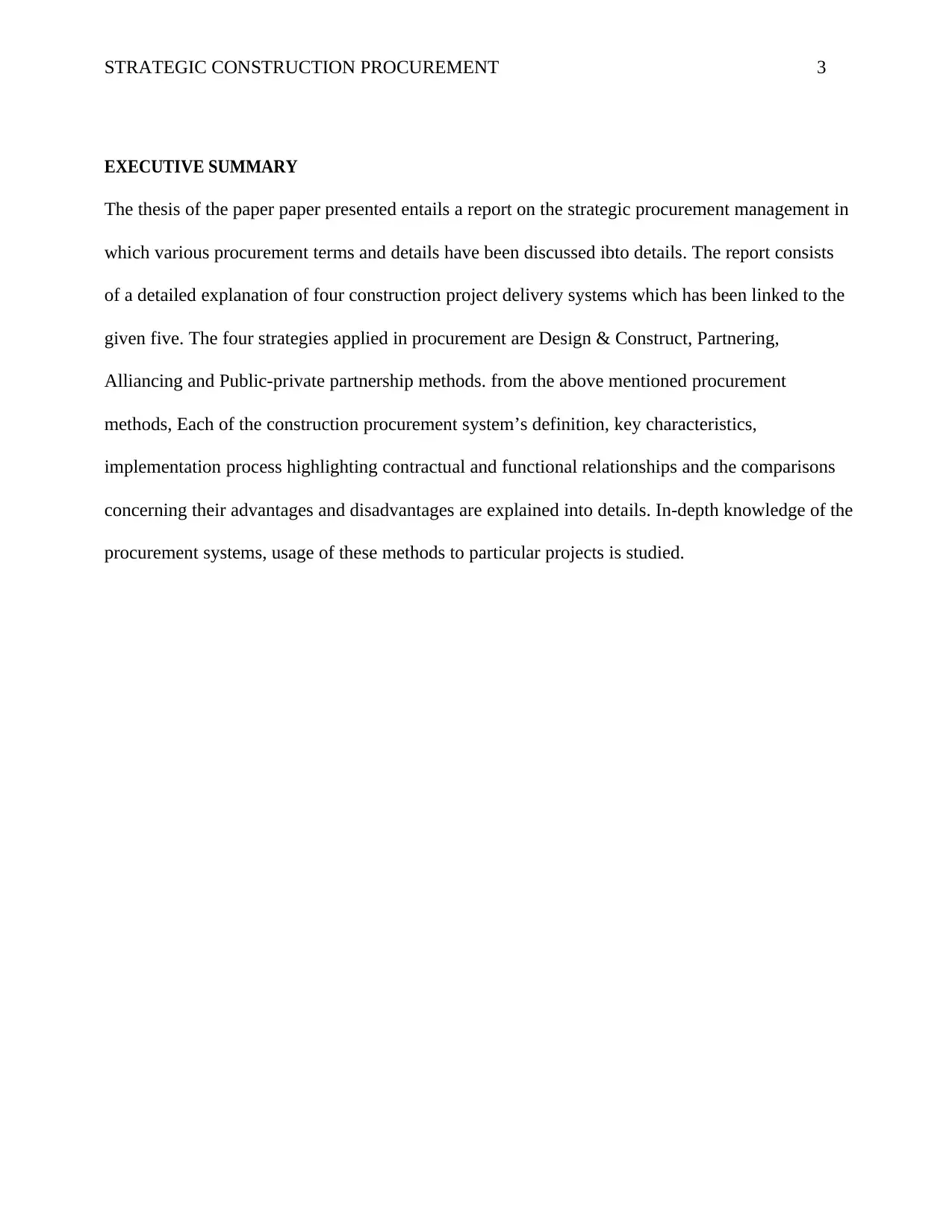
STRATEGIC CONSTRUCTION PROCUREMENT 3
EXECUTIVE SUMMARY
The thesis of the paper paper presented entails a report on the strategic procurement management in
which various procurement terms and details have been discussed ibto details. The report consists
of a detailed explanation of four construction project delivery systems which has been linked to the
given five. The four strategies applied in procurement are Design & Construct, Partnering,
Alliancing and Public-private partnership methods. from the above mentioned procurement
methods, Each of the construction procurement system’s definition, key characteristics,
implementation process highlighting contractual and functional relationships and the comparisons
concerning their advantages and disadvantages are explained into details. In-depth knowledge of the
procurement systems, usage of these methods to particular projects is studied.
EXECUTIVE SUMMARY
The thesis of the paper paper presented entails a report on the strategic procurement management in
which various procurement terms and details have been discussed ibto details. The report consists
of a detailed explanation of four construction project delivery systems which has been linked to the
given five. The four strategies applied in procurement are Design & Construct, Partnering,
Alliancing and Public-private partnership methods. from the above mentioned procurement
methods, Each of the construction procurement system’s definition, key characteristics,
implementation process highlighting contractual and functional relationships and the comparisons
concerning their advantages and disadvantages are explained into details. In-depth knowledge of the
procurement systems, usage of these methods to particular projects is studied.
⊘ This is a preview!⊘
Do you want full access?
Subscribe today to unlock all pages.

Trusted by 1+ million students worldwide
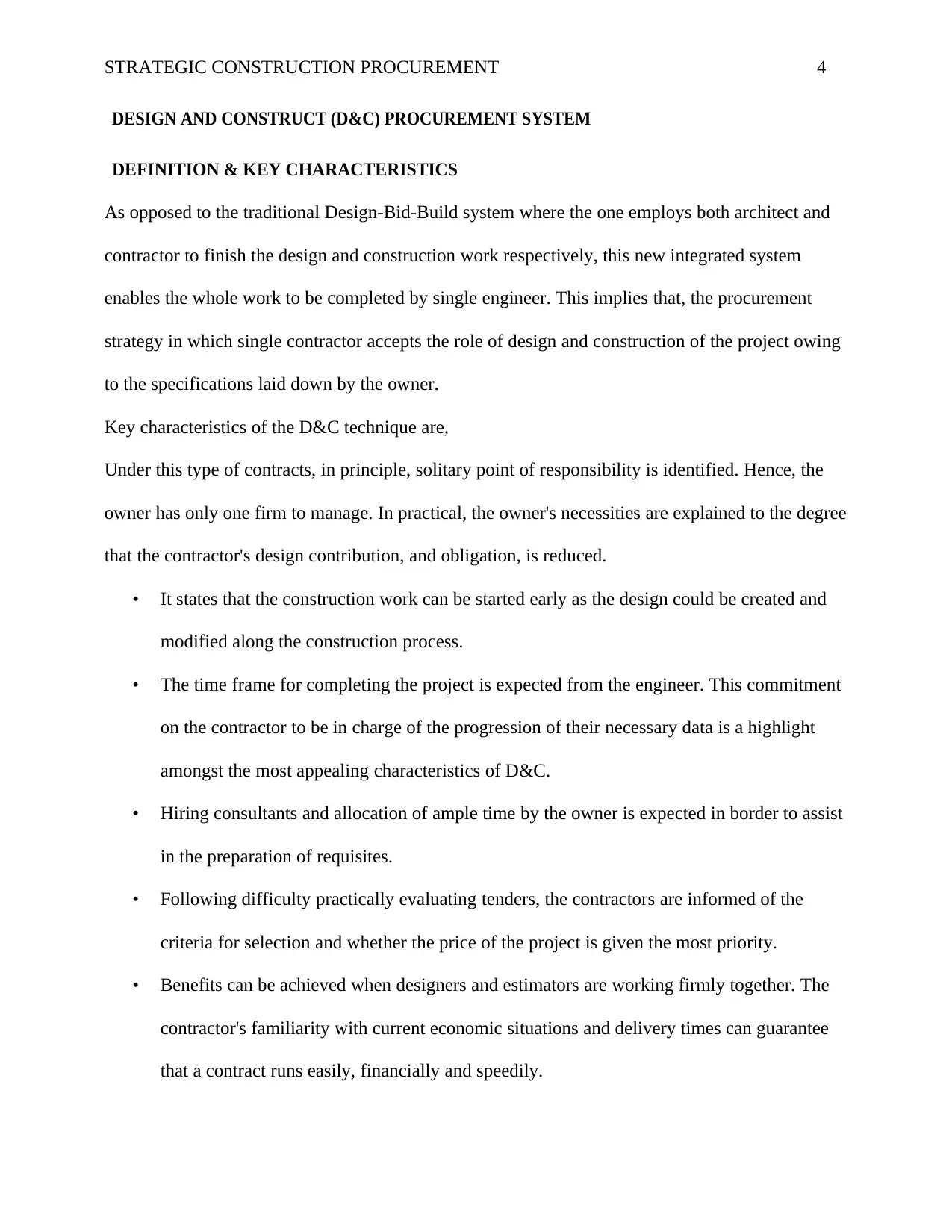
STRATEGIC CONSTRUCTION PROCUREMENT 4
DESIGN AND CONSTRUCT (D&C) PROCUREMENT SYSTEM
DEFINITION & KEY CHARACTERISTICS
As opposed to the traditional Design-Bid-Build system where the one employs both architect and
contractor to finish the design and construction work respectively, this new integrated system
enables the whole work to be completed by single engineer. This implies that, the procurement
strategy in which single contractor accepts the role of design and construction of the project owing
to the specifications laid down by the owner.
Key characteristics of the D&C technique are,
Under this type of contracts, in principle, solitary point of responsibility is identified. Hence, the
owner has only one firm to manage. In practical, the owner's necessities are explained to the degree
that the contractor's design contribution, and obligation, is reduced.
• It states that the construction work can be started early as the design could be created and
modified along the construction process.
• The time frame for completing the project is expected from the engineer. This commitment
on the contractor to be in charge of the progression of their necessary data is a highlight
amongst the most appealing characteristics of D&C.
• Hiring consultants and allocation of ample time by the owner is expected in border to assist
in the preparation of requisites.
• Following difficulty practically evaluating tenders, the contractors are informed of the
criteria for selection and whether the price of the project is given the most priority.
• Benefits can be achieved when designers and estimators are working firmly together. The
contractor's familiarity with current economic situations and delivery times can guarantee
that a contract runs easily, financially and speedily.
DESIGN AND CONSTRUCT (D&C) PROCUREMENT SYSTEM
DEFINITION & KEY CHARACTERISTICS
As opposed to the traditional Design-Bid-Build system where the one employs both architect and
contractor to finish the design and construction work respectively, this new integrated system
enables the whole work to be completed by single engineer. This implies that, the procurement
strategy in which single contractor accepts the role of design and construction of the project owing
to the specifications laid down by the owner.
Key characteristics of the D&C technique are,
Under this type of contracts, in principle, solitary point of responsibility is identified. Hence, the
owner has only one firm to manage. In practical, the owner's necessities are explained to the degree
that the contractor's design contribution, and obligation, is reduced.
• It states that the construction work can be started early as the design could be created and
modified along the construction process.
• The time frame for completing the project is expected from the engineer. This commitment
on the contractor to be in charge of the progression of their necessary data is a highlight
amongst the most appealing characteristics of D&C.
• Hiring consultants and allocation of ample time by the owner is expected in border to assist
in the preparation of requisites.
• Following difficulty practically evaluating tenders, the contractors are informed of the
criteria for selection and whether the price of the project is given the most priority.
• Benefits can be achieved when designers and estimators are working firmly together. The
contractor's familiarity with current economic situations and delivery times can guarantee
that a contract runs easily, financially and speedily.
Paraphrase This Document
Need a fresh take? Get an instant paraphrase of this document with our AI Paraphraser
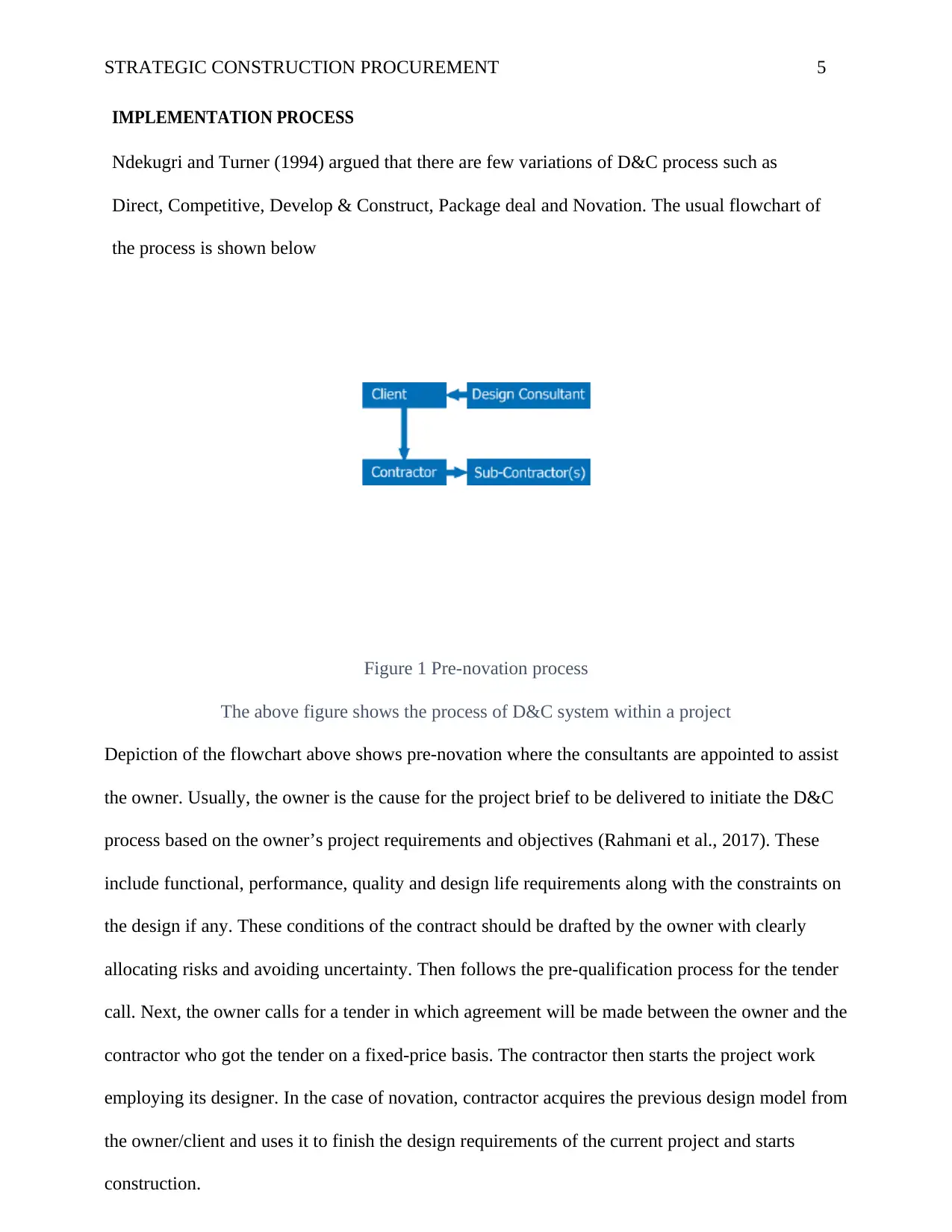
STRATEGIC CONSTRUCTION PROCUREMENT 5
IMPLEMENTATION PROCESS
Ndekugri and Turner (1994) argued that there are few variations of D&C process such as
Direct, Competitive, Develop & Construct, Package deal and Novation. The usual flowchart of
the process is shown below
Figure 1 Pre-novation process
The above figure shows the process of D&C system within a project
Depiction of the flowchart above shows pre-novation where the consultants are appointed to assist
the owner. Usually, the owner is the cause for the project brief to be delivered to initiate the D&C
process based on the owner’s project requirements and objectives (Rahmani et al., 2017). These
include functional, performance, quality and design life requirements along with the constraints on
the design if any. These conditions of the contract should be drafted by the owner with clearly
allocating risks and avoiding uncertainty. Then follows the pre-qualification process for the tender
call. Next, the owner calls for a tender in which agreement will be made between the owner and the
contractor who got the tender on a fixed-price basis. The contractor then starts the project work
employing its designer. In the case of novation, contractor acquires the previous design model from
the owner/client and uses it to finish the design requirements of the current project and starts
construction.
IMPLEMENTATION PROCESS
Ndekugri and Turner (1994) argued that there are few variations of D&C process such as
Direct, Competitive, Develop & Construct, Package deal and Novation. The usual flowchart of
the process is shown below
Figure 1 Pre-novation process
The above figure shows the process of D&C system within a project
Depiction of the flowchart above shows pre-novation where the consultants are appointed to assist
the owner. Usually, the owner is the cause for the project brief to be delivered to initiate the D&C
process based on the owner’s project requirements and objectives (Rahmani et al., 2017). These
include functional, performance, quality and design life requirements along with the constraints on
the design if any. These conditions of the contract should be drafted by the owner with clearly
allocating risks and avoiding uncertainty. Then follows the pre-qualification process for the tender
call. Next, the owner calls for a tender in which agreement will be made between the owner and the
contractor who got the tender on a fixed-price basis. The contractor then starts the project work
employing its designer. In the case of novation, contractor acquires the previous design model from
the owner/client and uses it to finish the design requirements of the current project and starts
construction.
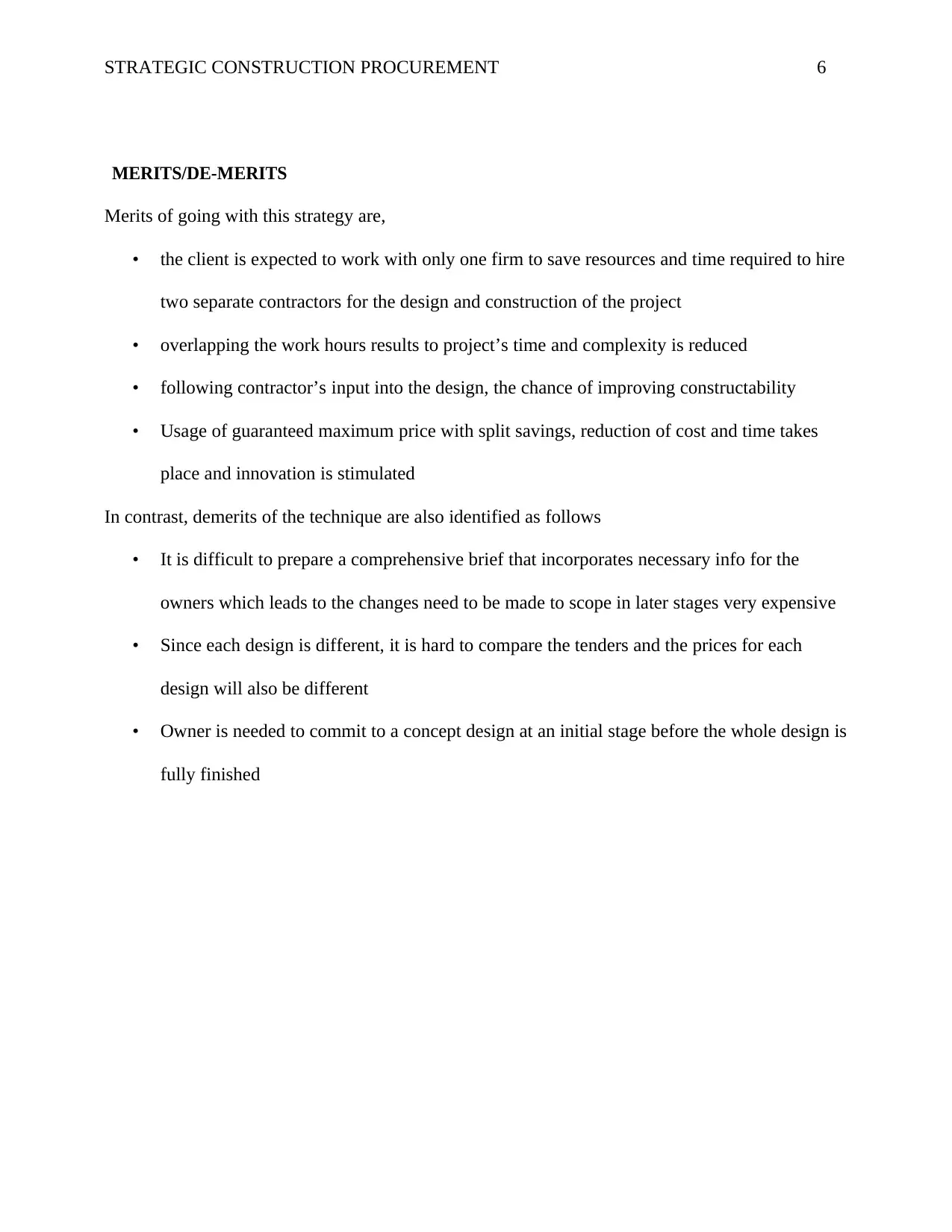
STRATEGIC CONSTRUCTION PROCUREMENT 6
MERITS/DE-MERITS
Merits of going with this strategy are,
• the client is expected to work with only one firm to save resources and time required to hire
two separate contractors for the design and construction of the project
• overlapping the work hours results to project’s time and complexity is reduced
• following contractor’s input into the design, the chance of improving constructability
• Usage of guaranteed maximum price with split savings, reduction of cost and time takes
place and innovation is stimulated
In contrast, demerits of the technique are also identified as follows
• It is difficult to prepare a comprehensive brief that incorporates necessary info for the
owners which leads to the changes need to be made to scope in later stages very expensive
• Since each design is different, it is hard to compare the tenders and the prices for each
design will also be different
• Owner is needed to commit to a concept design at an initial stage before the whole design is
fully finished
MERITS/DE-MERITS
Merits of going with this strategy are,
• the client is expected to work with only one firm to save resources and time required to hire
two separate contractors for the design and construction of the project
• overlapping the work hours results to project’s time and complexity is reduced
• following contractor’s input into the design, the chance of improving constructability
• Usage of guaranteed maximum price with split savings, reduction of cost and time takes
place and innovation is stimulated
In contrast, demerits of the technique are also identified as follows
• It is difficult to prepare a comprehensive brief that incorporates necessary info for the
owners which leads to the changes need to be made to scope in later stages very expensive
• Since each design is different, it is hard to compare the tenders and the prices for each
design will also be different
• Owner is needed to commit to a concept design at an initial stage before the whole design is
fully finished
⊘ This is a preview!⊘
Do you want full access?
Subscribe today to unlock all pages.

Trusted by 1+ million students worldwide
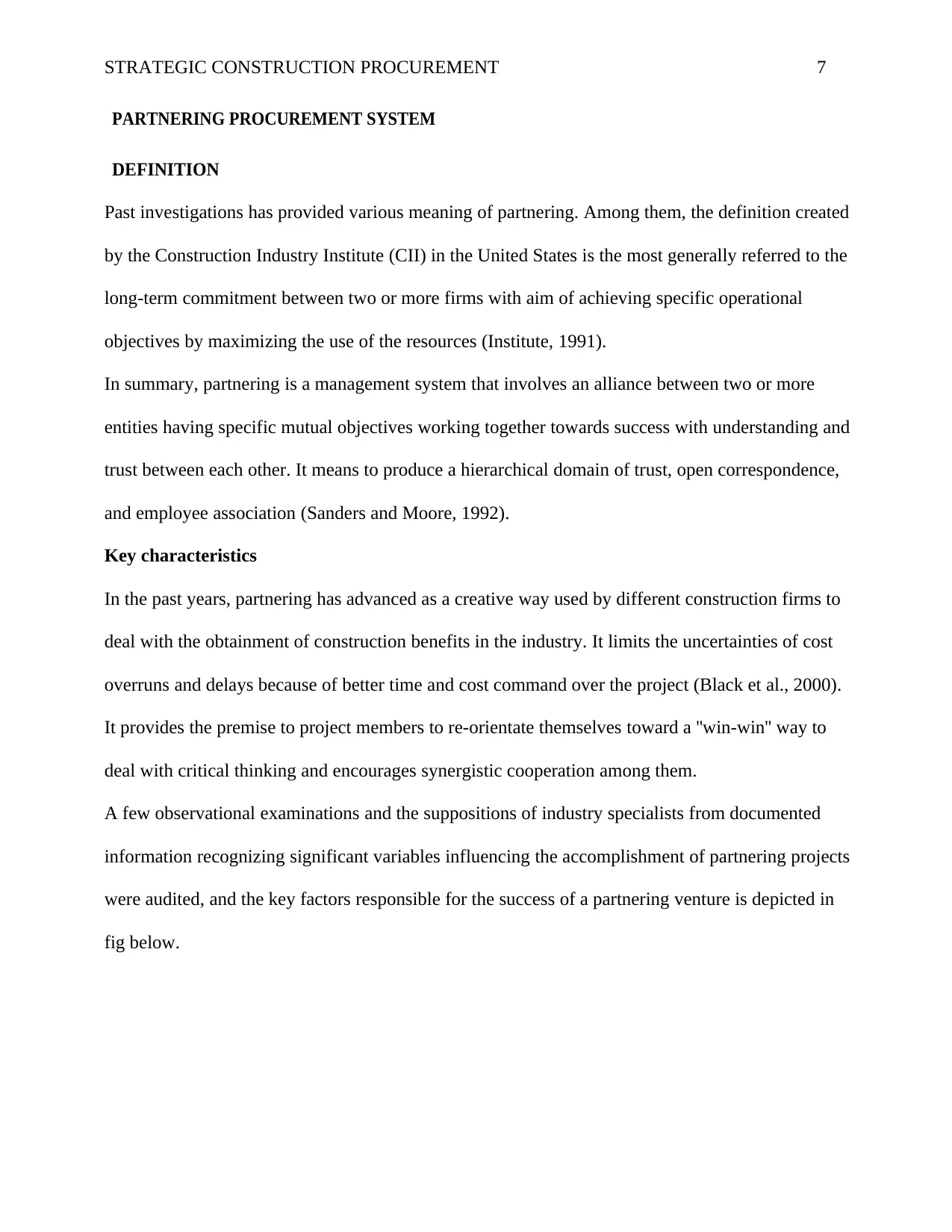
STRATEGIC CONSTRUCTION PROCUREMENT 7
PARTNERING PROCUREMENT SYSTEM
DEFINITION
Past investigations has provided various meaning of partnering. Among them, the definition created
by the Construction Industry Institute (CII) in the United States is the most generally referred to the
long-term commitment between two or more firms with aim of achieving specific operational
objectives by maximizing the use of the resources (Institute, 1991).
In summary, partnering is a management system that involves an alliance between two or more
entities having specific mutual objectives working together towards success with understanding and
trust between each other. It means to produce a hierarchical domain of trust, open correspondence,
and employee association (Sanders and Moore, 1992).
Key characteristics
In the past years, partnering has advanced as a creative way used by different construction firms to
deal with the obtainment of construction benefits in the industry. It limits the uncertainties of cost
overruns and delays because of better time and cost command over the project (Black et al., 2000).
It provides the premise to project members to re-orientate themselves toward a ''win-win'' way to
deal with critical thinking and encourages synergistic cooperation among them.
A few observational examinations and the suppositions of industry specialists from documented
information recognizing significant variables influencing the accomplishment of partnering projects
were audited, and the key factors responsible for the success of a partnering venture is depicted in
fig below.
PARTNERING PROCUREMENT SYSTEM
DEFINITION
Past investigations has provided various meaning of partnering. Among them, the definition created
by the Construction Industry Institute (CII) in the United States is the most generally referred to the
long-term commitment between two or more firms with aim of achieving specific operational
objectives by maximizing the use of the resources (Institute, 1991).
In summary, partnering is a management system that involves an alliance between two or more
entities having specific mutual objectives working together towards success with understanding and
trust between each other. It means to produce a hierarchical domain of trust, open correspondence,
and employee association (Sanders and Moore, 1992).
Key characteristics
In the past years, partnering has advanced as a creative way used by different construction firms to
deal with the obtainment of construction benefits in the industry. It limits the uncertainties of cost
overruns and delays because of better time and cost command over the project (Black et al., 2000).
It provides the premise to project members to re-orientate themselves toward a ''win-win'' way to
deal with critical thinking and encourages synergistic cooperation among them.
A few observational examinations and the suppositions of industry specialists from documented
information recognizing significant variables influencing the accomplishment of partnering projects
were audited, and the key factors responsible for the success of a partnering venture is depicted in
fig below.
Paraphrase This Document
Need a fresh take? Get an instant paraphrase of this document with our AI Paraphraser

STRATEGIC CONSTRUCTION PROCUREMENT 8
Figure 2 Success factors for Partnering
The above figure illustrates the success factors involved in a Partnering procurement system
Enough resources
Following the fact that construction resources are rare and competitive, it isn't normal for an
association to impart its assets to other people. These primary assets incorporate learning,
innovation, data, explicit abilities, and capital (Ndekugri and Turner, 1994) (Brooke and Litwin,
1997). It is likewise huge to learn the most extreme utilization of shared assets.
Support from higher management
With support from top management success of partnering in guaranteed since they are always key
factors for partnering project success. As senior administration plans the technique and direction
flow of business exercises, their full help and responsibility are basic in starting and driving the
partnering spirit (Cheng et al., 2000).
Mutual trust
Mutual trust towards other partners in the venture is considered significant for any partnering
venture to be fruitful. It is fundamental to ''open'' the limits of the relationship since it can alleviate
pressure and upgrade flexibility, data trade, joint critical thinking, and guarantee better results
(Cheng et al., 2000) (Bayramoglu, 2001).
Figure 2 Success factors for Partnering
The above figure illustrates the success factors involved in a Partnering procurement system
Enough resources
Following the fact that construction resources are rare and competitive, it isn't normal for an
association to impart its assets to other people. These primary assets incorporate learning,
innovation, data, explicit abilities, and capital (Ndekugri and Turner, 1994) (Brooke and Litwin,
1997). It is likewise huge to learn the most extreme utilization of shared assets.
Support from higher management
With support from top management success of partnering in guaranteed since they are always key
factors for partnering project success. As senior administration plans the technique and direction
flow of business exercises, their full help and responsibility are basic in starting and driving the
partnering spirit (Cheng et al., 2000).
Mutual trust
Mutual trust towards other partners in the venture is considered significant for any partnering
venture to be fruitful. It is fundamental to ''open'' the limits of the relationship since it can alleviate
pressure and upgrade flexibility, data trade, joint critical thinking, and guarantee better results
(Cheng et al., 2000) (Bayramoglu, 2001).
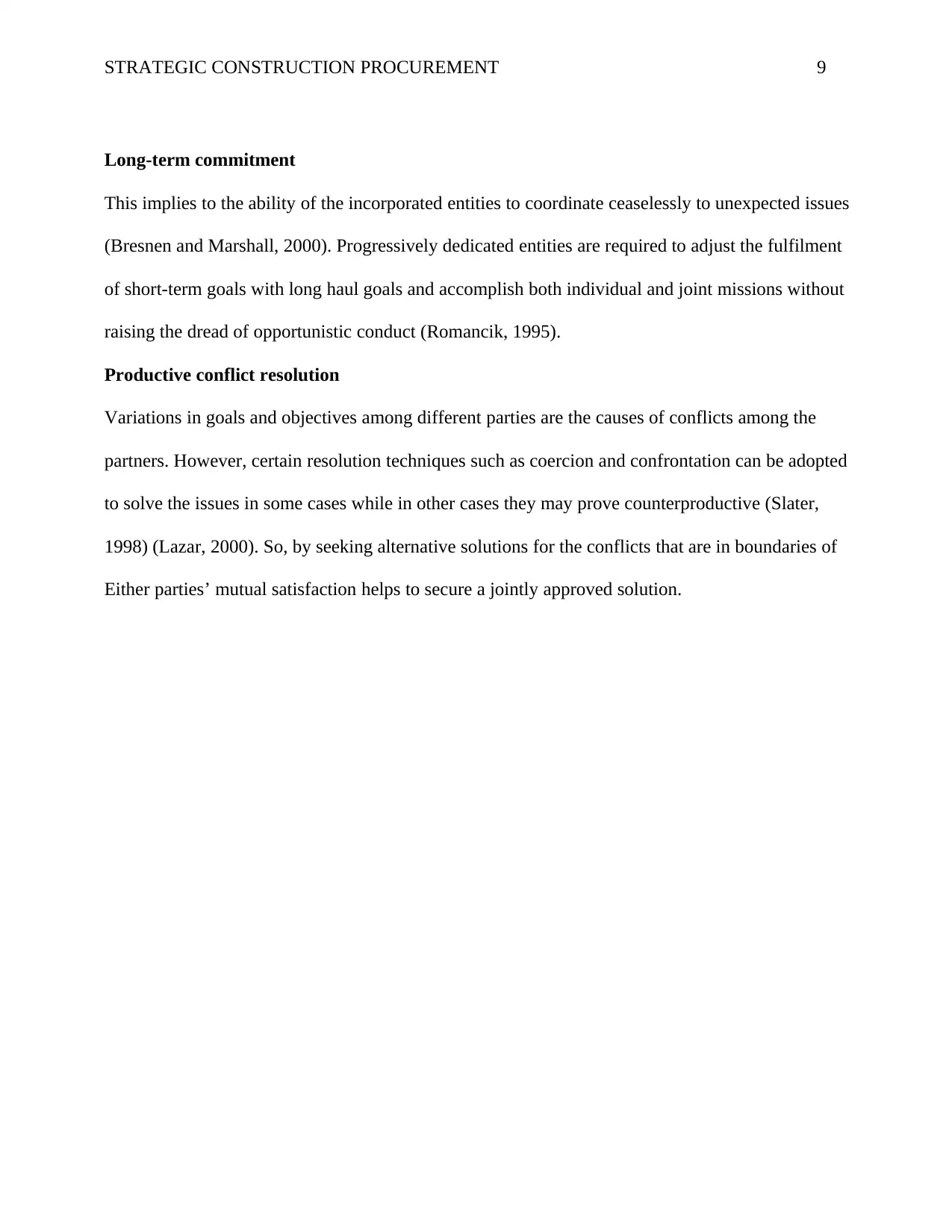
STRATEGIC CONSTRUCTION PROCUREMENT 9
Long-term commitment
This implies to the ability of the incorporated entities to coordinate ceaselessly to unexpected issues
(Bresnen and Marshall, 2000). Progressively dedicated entities are required to adjust the fulfilment
of short-term goals with long haul goals and accomplish both individual and joint missions without
raising the dread of opportunistic conduct (Romancik, 1995).
Productive conflict resolution
Variations in goals and objectives among different parties are the causes of conflicts among the
partners. However, certain resolution techniques such as coercion and confrontation can be adopted
to solve the issues in some cases while in other cases they may prove counterproductive (Slater,
1998) (Lazar, 2000). So, by seeking alternative solutions for the conflicts that are in boundaries of
Either parties’ mutual satisfaction helps to secure a jointly approved solution.
Long-term commitment
This implies to the ability of the incorporated entities to coordinate ceaselessly to unexpected issues
(Bresnen and Marshall, 2000). Progressively dedicated entities are required to adjust the fulfilment
of short-term goals with long haul goals and accomplish both individual and joint missions without
raising the dread of opportunistic conduct (Romancik, 1995).
Productive conflict resolution
Variations in goals and objectives among different parties are the causes of conflicts among the
partners. However, certain resolution techniques such as coercion and confrontation can be adopted
to solve the issues in some cases while in other cases they may prove counterproductive (Slater,
1998) (Lazar, 2000). So, by seeking alternative solutions for the conflicts that are in boundaries of
Either parties’ mutual satisfaction helps to secure a jointly approved solution.
⊘ This is a preview!⊘
Do you want full access?
Subscribe today to unlock all pages.

Trusted by 1+ million students worldwide
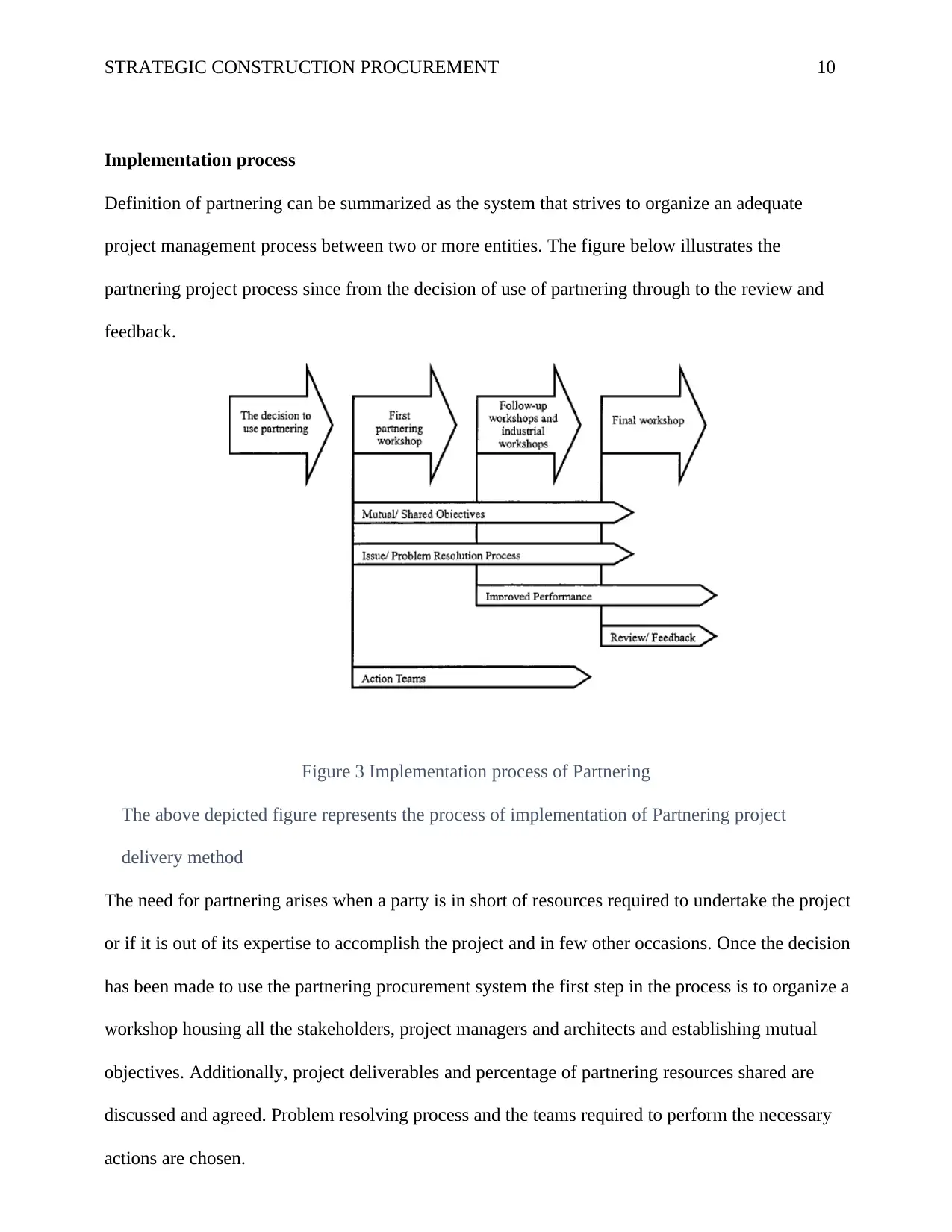
STRATEGIC CONSTRUCTION PROCUREMENT 10
Implementation process
Definition of partnering can be summarized as the system that strives to organize an adequate
project management process between two or more entities. The figure below illustrates the
partnering project process since from the decision of use of partnering through to the review and
feedback.
Figure 3 Implementation process of Partnering
The above depicted figure represents the process of implementation of Partnering project
delivery method
The need for partnering arises when a party is in short of resources required to undertake the project
or if it is out of its expertise to accomplish the project and in few other occasions. Once the decision
has been made to use the partnering procurement system the first step in the process is to organize a
workshop housing all the stakeholders, project managers and architects and establishing mutual
objectives. Additionally, project deliverables and percentage of partnering resources shared are
discussed and agreed. Problem resolving process and the teams required to perform the necessary
actions are chosen.
Implementation process
Definition of partnering can be summarized as the system that strives to organize an adequate
project management process between two or more entities. The figure below illustrates the
partnering project process since from the decision of use of partnering through to the review and
feedback.
Figure 3 Implementation process of Partnering
The above depicted figure represents the process of implementation of Partnering project
delivery method
The need for partnering arises when a party is in short of resources required to undertake the project
or if it is out of its expertise to accomplish the project and in few other occasions. Once the decision
has been made to use the partnering procurement system the first step in the process is to organize a
workshop housing all the stakeholders, project managers and architects and establishing mutual
objectives. Additionally, project deliverables and percentage of partnering resources shared are
discussed and agreed. Problem resolving process and the teams required to perform the necessary
actions are chosen.
Paraphrase This Document
Need a fresh take? Get an instant paraphrase of this document with our AI Paraphraser
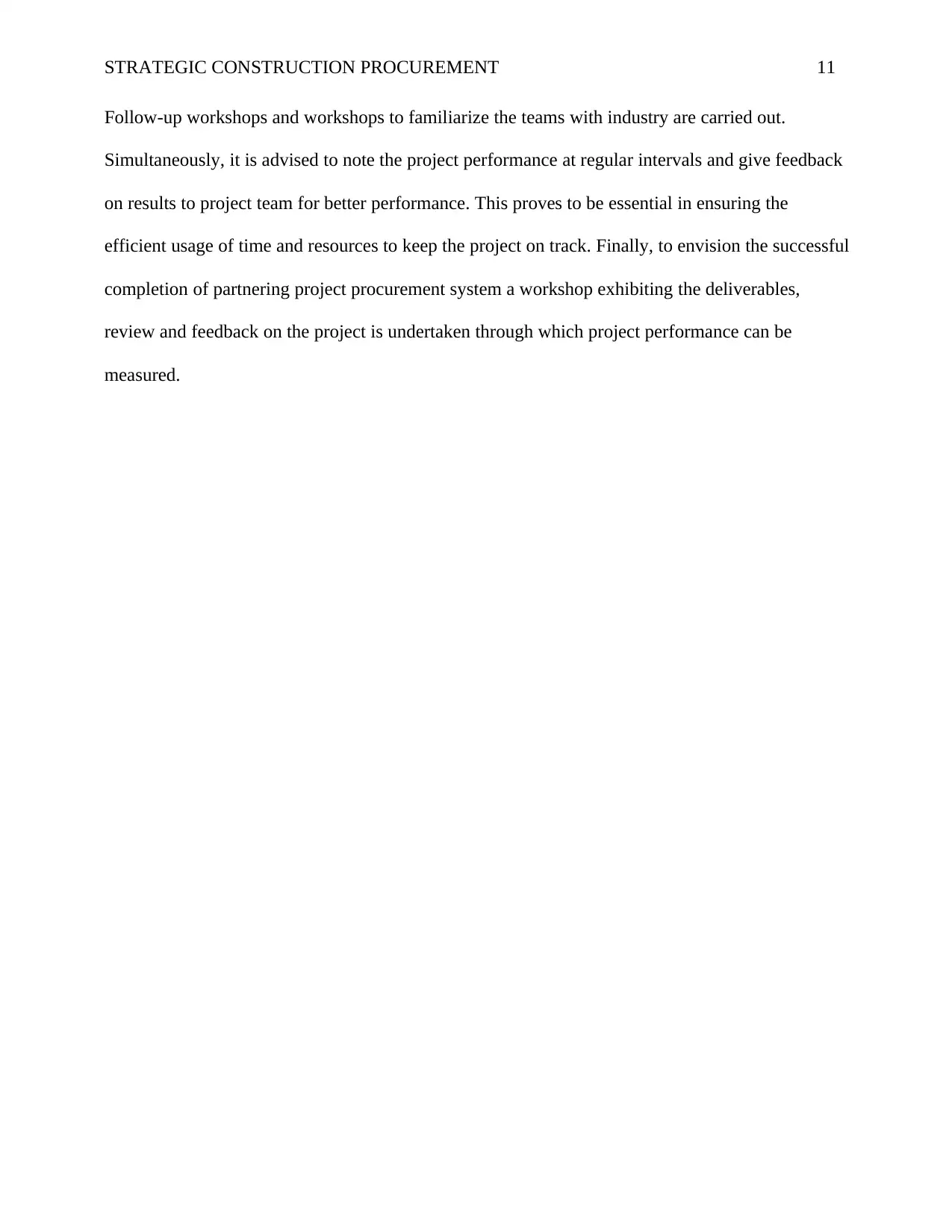
STRATEGIC CONSTRUCTION PROCUREMENT 11
Follow-up workshops and workshops to familiarize the teams with industry are carried out.
Simultaneously, it is advised to note the project performance at regular intervals and give feedback
on results to project team for better performance. This proves to be essential in ensuring the
efficient usage of time and resources to keep the project on track. Finally, to envision the successful
completion of partnering project procurement system a workshop exhibiting the deliverables,
review and feedback on the project is undertaken through which project performance can be
measured.
Follow-up workshops and workshops to familiarize the teams with industry are carried out.
Simultaneously, it is advised to note the project performance at regular intervals and give feedback
on results to project team for better performance. This proves to be essential in ensuring the
efficient usage of time and resources to keep the project on track. Finally, to envision the successful
completion of partnering project procurement system a workshop exhibiting the deliverables,
review and feedback on the project is undertaken through which project performance can be
measured.

STRATEGIC CONSTRUCTION PROCUREMENT 12
Merits/demerits & comparisons
The system is believed to efficiently maximize the utilization of each entity’s resources and helps in
achieving shared objectives. However, there are a considerable amount of downsides to housing
different parties with different objectives in one project giving rise to conflicts.
Some of the major merits and de-merits are tabularized below for easy understanding.
Table 1. Merits & De-merits of partnering procurement system
MERITS DE-MERITS
Reduced exposure to litigation Inhibition of developing new businesses
Lesser administrative costs Usage of cut-throat competition to win other
ventures
Improvement on the quality and project’s
related cost
Conflicts in decision making
Improved turnover and profits Limited open communication
Tailored service provision Chance to inhibit deep partner relationships
through commercial realities
Shared risks and resources
Merits/demerits & comparisons
The system is believed to efficiently maximize the utilization of each entity’s resources and helps in
achieving shared objectives. However, there are a considerable amount of downsides to housing
different parties with different objectives in one project giving rise to conflicts.
Some of the major merits and de-merits are tabularized below for easy understanding.
Table 1. Merits & De-merits of partnering procurement system
MERITS DE-MERITS
Reduced exposure to litigation Inhibition of developing new businesses
Lesser administrative costs Usage of cut-throat competition to win other
ventures
Improvement on the quality and project’s
related cost
Conflicts in decision making
Improved turnover and profits Limited open communication
Tailored service provision Chance to inhibit deep partner relationships
through commercial realities
Shared risks and resources
⊘ This is a preview!⊘
Do you want full access?
Subscribe today to unlock all pages.

Trusted by 1+ million students worldwide
1 out of 23
Related Documents
Your All-in-One AI-Powered Toolkit for Academic Success.
+13062052269
info@desklib.com
Available 24*7 on WhatsApp / Email
![[object Object]](/_next/static/media/star-bottom.7253800d.svg)
Unlock your academic potential
Copyright © 2020–2025 A2Z Services. All Rights Reserved. Developed and managed by ZUCOL.





